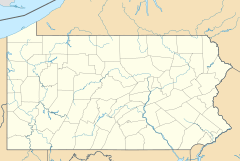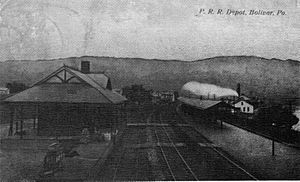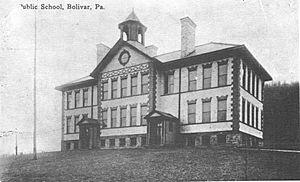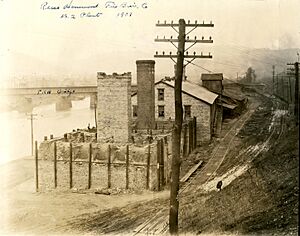Bolivar, Pennsylvania facts for kids
Quick facts for kids
Bolivar, Pennsylvania
|
|
|---|---|
|
Borough
|
|
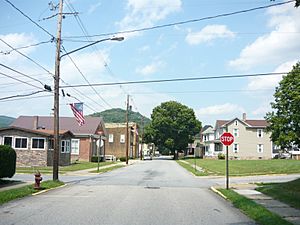
Washington Street
|
|
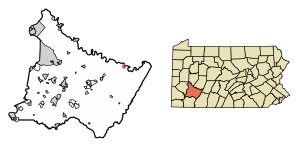
Location of Bolivar in Westmoreland County, Pennsylvania.
|
|
| Country | United States |
| State | Pennsylvania |
| County | Westmoreland |
| Settled | 1829 |
| Incorporated | November 25, 1863 |
| Government | |
| • Type | Borough Council |
| Area | |
| • Total | 0.18 sq mi (0.46 km2) |
| • Land | 0.17 sq mi (0.44 km2) |
| • Water | 0.01 sq mi (0.02 km2) |
| Elevation | 1,099 ft (335 m) |
| Population
(2020)
|
|
| • Total | 435 |
| • Density | 2,543.86/sq mi (984.97/km2) |
| Time zone | UTC-5 (Eastern (EST)) |
| • Summer (DST) | UTC-4 (EDT) |
| Zip code |
15923
|
| FIPS code | 42-07480 |
Bolivar (pronounced "BAH-lih-ver," like "Oliver") is a small town called a borough in Westmoreland County, Pennsylvania, United States. In 2020, about 436 people lived there.
Contents
Where is Bolivar?
Bolivar is located in Westmoreland County, Pennsylvania. It sits on the northern edge of Fairfield Township. The town is right next to the Conemaugh River.
The borough is quite small, covering about 0.2 square miles (0.46 square kilometers). Most of this area is land, with a small part being water.
Bolivar's Population Over Time
| Historical population | |||
|---|---|---|---|
| Census | Pop. | %± | |
| 1860 | 40 | — | |
| 1870 | 298 | 645.0% | |
| 1880 | 378 | 26.8% | |
| 1890 | 410 | 8.5% | |
| 1900 | 486 | 18.5% | |
| 1910 | 518 | 6.6% | |
| 1920 | 766 | 47.9% | |
| 1930 | 783 | 2.2% | |
| 1940 | 811 | 3.6% | |
| 1950 | 828 | 2.1% | |
| 1960 | 716 | −13.5% | |
| 1970 | 668 | −6.7% | |
| 1980 | 706 | 5.7% | |
| 1990 | 544 | −22.9% | |
| 2000 | 501 | −7.9% | |
| 2010 | 465 | −7.2% | |
| 2020 | 436 | −6.2% | |
| 2021 (est.) | 433 | −6.9% | |
| Sources: | |||
In 2000, there were 501 people living in Bolivar. These people lived in 200 households, with many being families. The population has changed over the years, as you can see in the table.
About 18% of the people were under 18 years old. The average age in Bolivar was 45 years. For every 100 females, there were about 93 males. Most residents were White, with smaller numbers of African American, Native American, and Asian people.
History of Bolivar
The first people settled in Bolivar around 1829. They built their homes between Tubmill Creek and the Conemaugh River. Many of the early settlers worked on the Pennsylvania Canal, which was a waterway used for transportation. You can still see some parts of the old canal west of town.
Early Industries: Brickyards and Railroads
Small brickyards soon started in the area. They made red bricks, and some houses on Second Street were built with these bricks. These old brick houses are still standing today!
In 1846, the Pennsylvania Railroad was built, taking the place of the canal. More brickyards were built near the river and the railroad. Bolivar became known as a "Brick Town" because of all the bricks it produced.
In 1863, Bolivar officially became a borough. This meant it could govern itself, separate from Fairfield Township. It was designed with a checkerboard street pattern, common for towns at that time.
Growth and Challenges
More brickyards were built on the north side of the Conemaugh River. This area was good for new factories because of the new Western Pennsylvania Railroad and easy access to coal and clay. One brickyard, No. 4, was once the largest in North America! It could make 100,000 paving blocks every day. The Robinson Brothers also built a brickyard, which is now known as Garfield Refractories Co.
Around 1900, a man named J. B. Hammond took control of several brickyards in Bolivar. This time was called "The Golden Era of Bolivar." There were plans for a big hotel and a department store, and even central heating pipes were laid under the streets. However, a financial panic in 1902 caused the bank to fail and the brickyards to face problems.
Second Boom and the Great Depression
From 1914 to the 1920s, Bolivar had another period of growth. New companies took over the brickyards. Coal mines like Lacolle Mine and Ridgeview Coal Mines opened, shipping lots of coal. Many people found jobs in mining, lumber, and manufacturing.
However, Bolivar was hit hard by the Great Depression in the 1930s. Many businesses closed down and were never replaced. Bolivar lost six brickyards, two large coal companies, restaurants, a flour mill, a railroad station, banks, a lumber yard, and even its opera house and movie theater.
In more recent times, the Antiochian Village was established in Bolard in 1978. It hosted an important meeting of American bishops in 1994.
See also
 In Spanish: Bolivar (Pensilvania) para niños
In Spanish: Bolivar (Pensilvania) para niños


